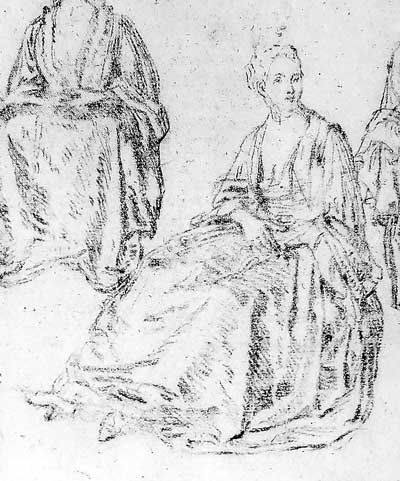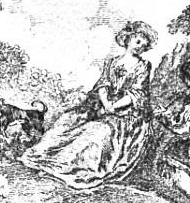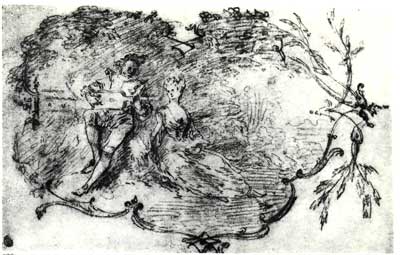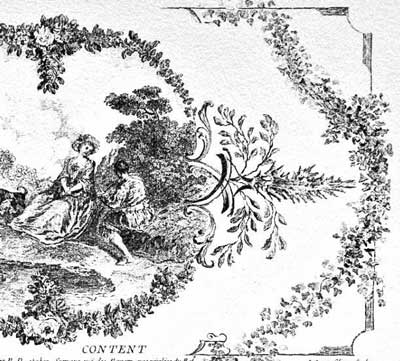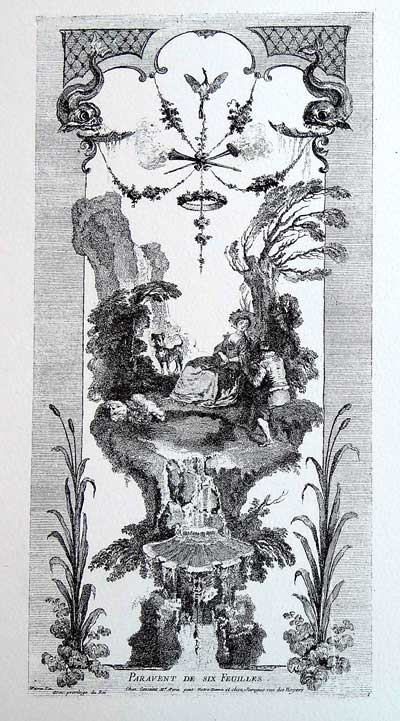
- Home Page
- Accepted
Paintings & Copies - Doubtful
Attributions - Doubtful Textual References
- Alternative
Titles - Collectors &
Museums - Bibliography
- Search Abecedario
- Watteau &
His Circle
Le Berger content
Entered June 2016; revised September 2025

Presumed lost
Materials unknown
Measurements unknown
RELATED PRINTS
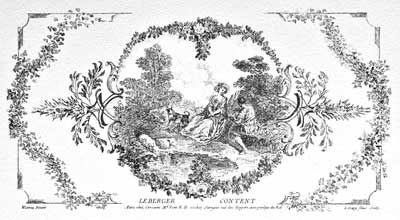
Louis Crépy fils after Watteau, Le Berger content, c. 1729, engraving.
This decorative composition was engraved by Louis Crépy fils and was announced for sale in the April 1729 issue of the Mercure. The caption to the engraving states “Watteau pinxit,” the "pinxit" assuring us that the print was made from a painted arabesque and not just a preparatory drawing.
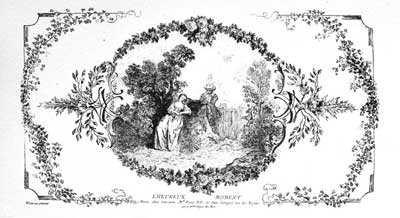
Louis Crépy fils after Watteau, L’Heureux moment, c. 1729, engraving.
Le Berger content and its pendant, L’Heureux moment, also engraved by Crépy, were announced as part of a suite of four decorative designs. The other two, Le Marchand d’orvietan and La Favorite de Flore, were engraved by Jean Moyreau. Those figures are in a different scale and the decorative surrounds are unrelated to those in the first set. In other words, the two sets are unrelated.
Dacier, Vuaflart, and Hérold cite two copies after Le Berger content. One is a smaller, reversed image, without mention of Watteau’s name, and is signed “B. Picart direxit.” The second is an etching, is vertically oriented, and has only the two central figures and a house seen under the trees. The changes in the latter are somewhat analogous to those found in the picture in the Louvre (copy 1).
SELECT BIBLIOGRAPHY
Mariette, “Notes manuscrites,” 9: fol. 198.
Goncourt, L’Art au XVIIIème siècle (1860), 59.
Goncourt, Catalogue raisonné (1875), cat. 300.
Zimmermann, Watteau (1912), under pl. 147.
Dacier, Vuaflart, and Hérold, Jean de Jullienne et les graveurs (1921-29), cat. 7.
Rahir, Watteau, peintre d’arabesques (1922), cat. 68.
Réau, “Watteau” (1928), cat. 269.
Adhémar, Watteau (1950), cat. 27.
Macchia and Montagni, L’opera completa di Watteau (1968), cat. 39A.
Eidelberg, “Huquier, Friend or Foe of Watteau” (1984), 160, 164.
Le Coat, "Watteau et l'imaginaire social" (1984), 182.
Grasselli, “Eighteen Drawings by Watteau” (1993), 126 n. 13.
Rosenberg and Prat, Watteau, catalogue raisonné des dessins (1996), cat. 183, R658.
Eidelberg, “How Watteau Designed His Arabesques” (2003), 71.
RELATED DRAWINGS
The one Watteau figure study that is related to the painting is known through a counterproof in Stockholm (Rosenberg and Prat 183). While the seated woman in the counterproof has much in common with the painted figure, there are significant differences. In the painting, the woman’s head and shoulders are steeply inclined, she wears a prominent hat, and her shoes are not as visible. It may well have been this drawing that informed Le Berger content since another study on this same sheet was used for Berger auprès d’un bergère, one panel of a six-leaved screen that also contains a version of Le Berger content (discussed below).
We are on firmer ground when discussing the arabesque enframement of Le Berger content. The bilateral arrangement of leafy branches and arcs is derived directly from a drawing that has not been seen for many decades (Rosenberg and Prat R658). This drawing, accepted by Parker and Mathey, Grasselli, and myself, was rejected by Rosenberg and Prat. However, it conforms in every aspect to the way in which Watteau planned his arabesques. The figures are drawn rapidly but precisely, and he has offered two different solutions for the decorative enframement. He chose the design on the right side for Le Berger content and its pendant, L’Heureux moment, but added a branch to the central horizontal axis.
Moreover, Gabriel Huquier utilized elements from this same drawing to create additional arabesques (Le Duo champêtre and Le Present champêtre) that he falsely attributed to Watteau. While not proof per se of Watteau’s authorship, Huquier's reliance on Watteau drawings lends further credence to the belief that this study is autograph.
REMARKS
Although Watteau rarely repeated his compositions, Le Berger content is one of those rare instances where he did. He employed the same central vignette of the shepherd, shepherdess, dog, and tree for Berger jouant de la flûte, one section of a six-leafed screen. However, other elements of the composition, especially the landscape and surrounding arabesque, are quite different.
All indications point to Le Berger content as an early work. Not only are almost all Watteau’s arabesques associated with the artist’s stay with Claude Audran, c. 1709-12, but also the two drawings—that of the woman and the ornamental study—are similarly dated to this early phase of Watteau’s career.
For copies of Le Berger content CLICK HERE
